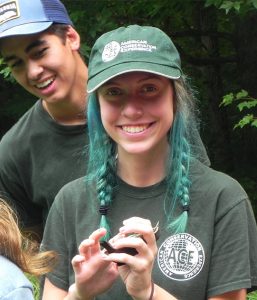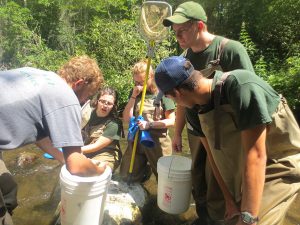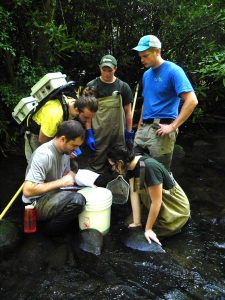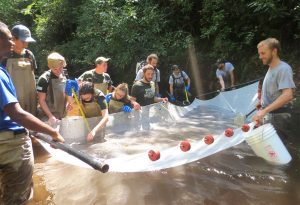by Nicole Welbourn
GSMNP Intern
Senior at School of Inquiry and Life Sciences — Asheville, North Carolina

Working with the Fisheries division and volunteers from Trout Unlimited to inventory fish in the Little Cataloochee was a special activity for me.
We received a safety briefing, waders, and gloves since we would be working with electroshock methods. We were working in a low conductivity river, which means that our shocks would be strong in a small radius rather than weaker in a large radius. To temporarily stun the fish we used a 600-volt shock. By comparison, the outlets in your house are only 125 volts, so we were working with extremely high electricity.
We divided into three groups — two of them using electroshocking and one using a large net. I was excited to be with one of the electroshock groups. It essentially takes three people to efficiently capture fish.

One person is shocking the water using a probe that’s connected to a backpack, which looks like it is straight out of a Ghostbusters movie. That person also has a net in the other hand to catch the stunned fish.
The next person stays close behind with another net that they keep directly behind the shock rod. As the fish are shocked they float up, and you swiftly capture fish (and sometimes salamanders and crawdads). If the second person has a fish in their net they can put it directly in the bucket. If the first person catches a fish, they must first pass it to the second person to put in the bucket, thus diluting the electricity.

The third person’s job is to hold the bucket half-full of water and trail behind, waiting to receive the fish.
Our group went upstream, staying relatively close to the shoreline. In our first haul we caught a few rainbow trout, a stoneroller (admired its beautiful color), and asked a lot of questions.
Caleb Abramson, a fisheries technician, gave us a quick history lesson of the ramifications of logging and how the rainbow trout and brown trout had been “introduced” into streams and rivers in the Smokies.
The only native trout species to the park is the brook trout that struggles to live in harmony with the other two species. In some of the smaller streams, the park service worked to clear out all the non-native species and then reintroduced the brook trout in an attempt to restore how it naturally would have been.
Most brook trout can be found only in the isolated, high elevation mountains in the park because of the loggers. The rivers were being polluted with dirt and debris from logging trails, but loggers never tainted the rivers higher in elevation because the trees were too hard to get to and transporting the logs was too difficult.
Another one of our hauls resulted in a bucket containing all three types of trout, which was great to see.

We were also surprised to see that one of the fish had three leeches attached to it, which Caleb had never seen before.
After we logged the data about what we had collected, as well as some observations, I got to hold some of the fish and then we released them back into the water.
Caleb was a little disappointed to not have found any hogsuckers, which also populate the stream.
I really enjoyed working with fish and the thrill of never knowing what you would catch.
I feel much more informed about the Smokies fish populations than I had before, and the experience sparked an interest in the Wildlife and Fisheries Division.
We worked with about ten Fisheries workers, and they were all men. Caleb assured us this wasn’t a “boys’ club,” and there have been women who have worked in fisheries and were very talented at capturing fish.
I would love to see the female population represented more in this field and maybe be in it myself one day.
***

This is the second in a series of blog posts by high school students participating in the Great Smoky Mountains National Park Summer Internship Program. This summer, 19 students are participating, representing high schools in North Carolina and Tennessee that are near the Great Smoky Mountains National Park.
The program is funded by both the Youth Partnership Program and Friends of the Smokies. FOTS has supported the program for 16 years, initially providing the salaries for the interns and now funding the program staff salaries.
The program is designed to give the interns a little taste of a variety of activities that rangers are involved with – from fisheries science to botany to forest and stream ecology. The interns gain an understanding of how the park is managed and are introduced to possible career opportunities.
The first blog post, by Hannah Ensley, was an introduction to the program.
